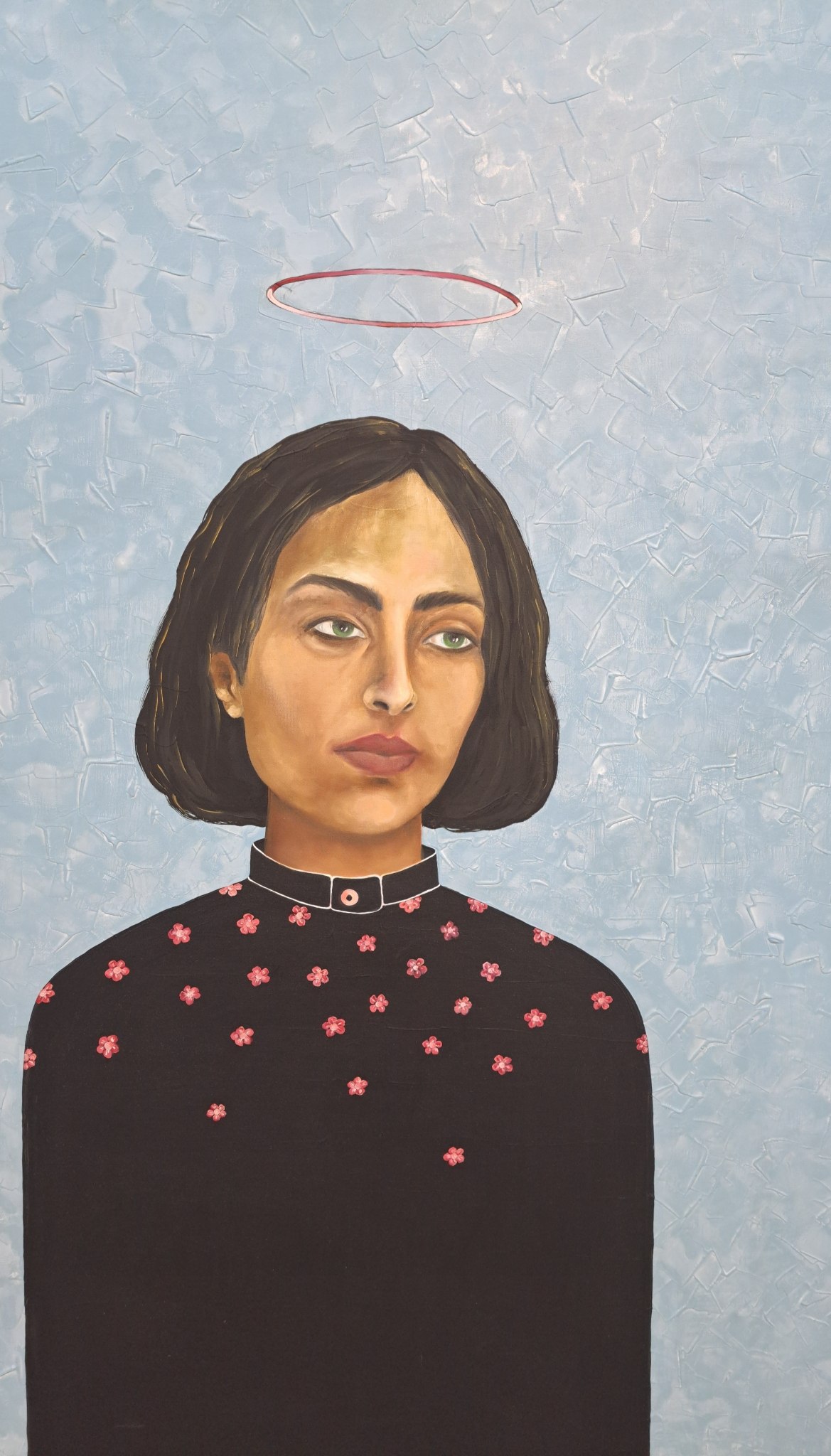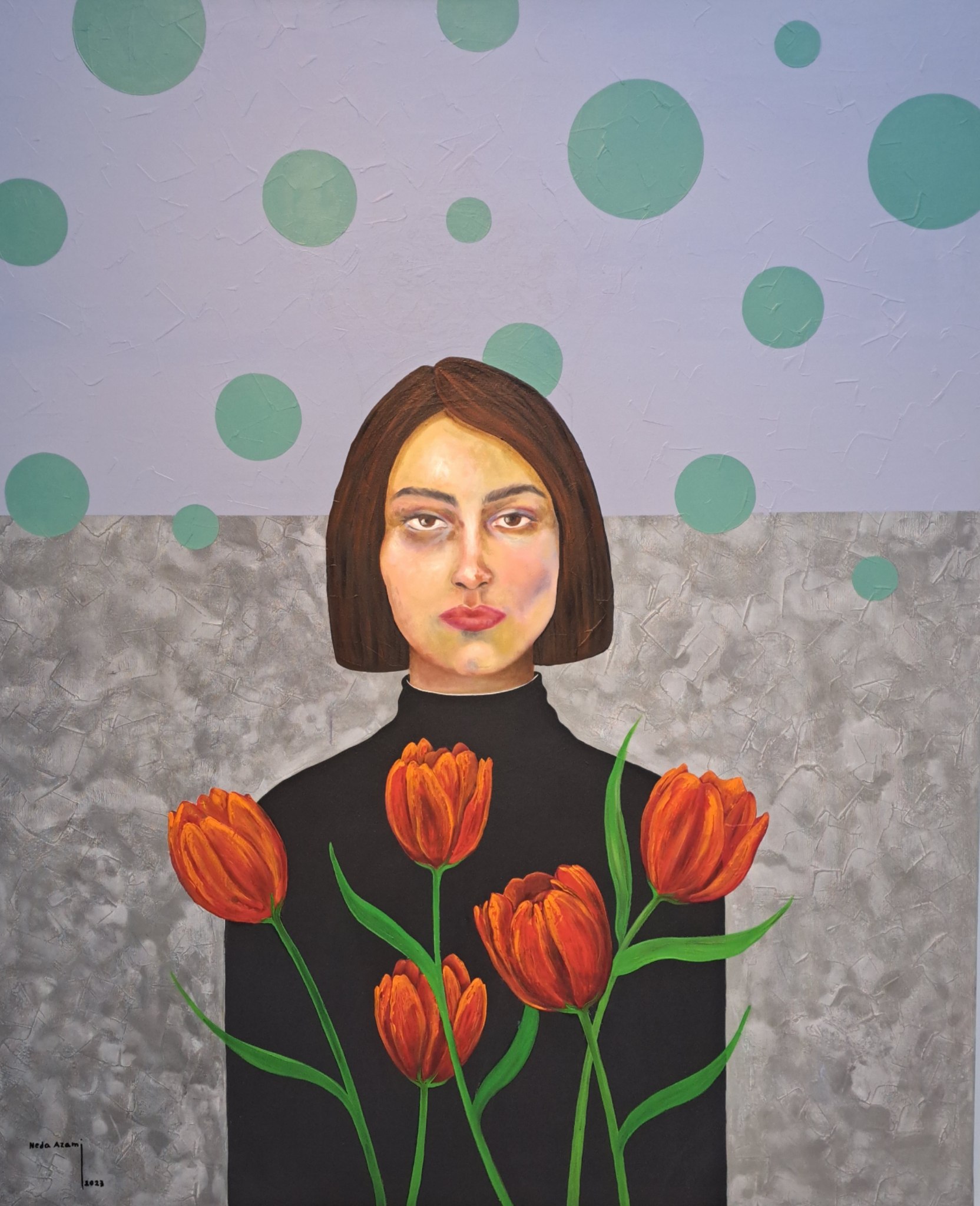نگاهی به نمایشگاه «سکوت شخصی» ندا اعظمی به قلم امیرحسین شریفان
این نوشتار، زاویه نگاهی است شخصی و تحلیلی در مواجه با نمایشگاه انفرادی نقاشی های ندا اعظمی که در تابستان 1404 در گالری ابتدا، به نمایش گذاشته شده است.
تمام حقوق این نوشته برای امیر حسین شریفان محفوظ است، استفاده با ذکر منبع مجاز است.
ارجاع به این متن :
https://amirhosseinsharifan.ir/blog/art-analysis-criticism/P1061-A-Look-at-Neda-Azami-s-Exhibition-Personal-Silence-by-Amirhossein-Sharifan.html
واژگان کلیدی: گالری ابتدا، ندا اعظمی، سکوت شخصی، انسان معاصر، پدیدارشناسی، ادراک، پرتره نگاری، بازنمایی چهره، پرتره

«سکوت شخصی» ندا اعظمی در ظاهر یک مجموعهی پرتره است، اما در لایههای درونیتر خود چیزی فراتر از بازنمایی چهره را دنبال میکند. این آثار همچون عرصهای برای تأمل در باب سکوت و وضعیت وجودی انسان معاصر گشوده میشوند؛ سکوتی که نه غیاب صدا، بلکه حضوری مقاوم و اندیشنده است. پرترههای او در مرکز بوم نشستهاند، بیهیچ حرکت یا ژستی که ما را به سوی داستانی بیرونی هدایت کند. ثبات و انجماد این چهرهها یادآور لحظهای ابدی است؛ لحظهای که از جریان خطی زمان جدا شده و به تجربهای مدیتاتیو و مکاشفهگرانه بدل میشود. سکوت در اینجا خود زبان است، زبانی بیکلمه که با هر نگاه، معنا را از مسیر تصویر منتقل میکند.
به نقل از هنرمند، چهرهها آینههایی هستند که چیزی را نمایش نمیدهند، بلکه چیزی را بازتاب میدهند و این زنان، حاضر به نظر میآیند ولی ذهنشان در دنیای دیگری پرسه میزند، بین رویا، خاطره و سکوت شخصی.
همین جمله میتواند کلید درک این مجموعه باشد، زیرا پرترهها بیش از آنکه روایتگر یک «دیگری» باشند، پژواک درونی مخاطب را بازمیتابانند. چهرهها در نگاه مستقیم و لبهای بستهشان، بیننده را با سکوتی روبهرو میکنند که راه گریزی ندارد؛ گویی در آینهی خاموش این زنان، ما با خودِ ناپیدای خویش مواجه میشویم.
پسزمینههای یکدست و خلوت ـ صورتی، آبی و ... ـ از هرگونه روایت خارجی تهی شدهاند. این رنگها نه تزئیناند و نه صرفاً انتخابی زیباشناسانه، بلکه همچون پردهای از خلأ عمل میکنند، خلائی که مخاطب را ناگزیر میسازد نگاه خود را بر چهره متمرکز کند. این تهیسازی جهان بیرونی، یادآور پدیدارشناسی مرلوپونتی است؛ جایی که ادراک نه از بیرون، بلکه از طریق مواجههی بدنمند و مستقیم با پدیده شکل میگیرد. در اینجا، چهره به پدیداری ناب بدل شده است؛ حضوری که هیچ واسطهای آن را مخدوش نمیسازد.
در دل این سکوت بصری، نشانهها و نمادهای ظریف، چون ترکهایی بر سطح انجماد عمل میکنند. گلهای لالهی نارنجی بهسان جوشش زندگی در سکون، دایرههای رنگی همچون امواج ذهن و خاطره، و هالههای نورانی بر فراز سر برخی پرترهها که یادآور قداست سکوت و شاید ارجاع به قدیسنگاری است، همگی زمزمههایی کوتاه در دل خاموشیاند. این نمادها در سکوت فرومیروند، اما بهمحض دیدهشدن، افق معنایی تازهای را میگشایند. سکوت در اینجا مطلق نیست؛ سکوتی است که درون خود صداهای پنهان دارد، زمزمههایی که شنیدنشان تنها با درنگ و مکث ممکن میشود.

تکرار در آثار اعظمی، کیفیتی مراقبهوار دارد. هر پرتره با آنکه از ساختاری مشابه تبعیت میکند، در جزئیات متفاوت است: تغییر پسزمینه، تغییر نمادها، تغییر رنگ. این تکرار با تفاوت، ما را به یاد ریتم مراقبه یا تکرار مانترا میاندازد؛ تجربهای که با هر بار بازگشت به همان تصویر، عمق بیشتری از سکوت را آشکار میسازد. مخاطب در مواجهه با این تکرار نه دچار ملال، بلکه وارد لایهای پیوسته از تفکر و مکاشفه میشود. این همان جایی است که سکوت به تجربهای وجودی بدل میگردد: سکوتی که هر بار با تکرار، معنای تازهای میآفریند.
اما سکوت در این آثار تنها تجربهای فردی نیست؛ بُعد اجتماعی و مقاومتی نیز دارد. در جهانی که پیوسته در معرض سیل کلمات، تصاویر و روایتهاست، سکوت میتواند نوعی کنش اعتراضی باشد. چهرههای بیصدا و بیهیجان این مجموعه، با نگاه مستقیم و لبهای بستهی خود در برابر این هجوم مقاومت میکنند. آنها از حضور خاموش خویش دفاع میکنند و به ما یادآوری مینمایند که سکوت نیز نوعی گفتوگوست؛ گفتوگویی که نه در سطح زبان، بلکه در عمق تجربهی انسانی شکل میگیرد. سکوت در اینجا به آن چیزی نزدیک میشود که رولان بارت از آن بهعنوان «خروج از زبان» یاد میکرد: گریز از سلطهی گفتار و یافتن فضایی دیگر برای بیان.
ندا اعظمی با «سکوت شخصی» در ادامهی جریان پرترهنگاری معاصر ایران حرکت میکند، اما با حذف داستانپردازی و اتکای صرف بر سکوت و ایستایی، مسیرش را به سوی هنر مفهومی و مینیمالیسم میگشاید. آنچه در این آثار اهمیت دارد، نه هویت تاریخی یا اجتماعی مدلها، بلکه وضعیت روانی انسان امروز است؛ انسانی که در کشاکش میان دنیای درون پرهیاهو و بیرون خاموش، لحظهای در سکوت متوقف شده است. انسجام مفهومی و یکپارچگی بصری مجموعه، آن را به بیانیهای تصویری بدل کرده که از مرز پرتره فراتر میرود. بااینحال، همین انسجام و تکرار ممکن است برای برخی مخاطبان بهمثابه مرزی امن به نظر برسد؛ گویی هنرمند در نقطهای مطمئن توقف کرده و کمتر به ریسکهای فرمی تن داده است. اما شاید این نیز بخشی از معنای کار باشد: سکوتی که با پافشاری و تداوم خود، به حضوری پایدار بدل میشود.
در نهایت، «سکوت شخصی» تجربهای است که ما را به مکث وامیدارد، مکثی که در آن چهرههای خاموش زنان نه بهعنوان سوژههای منفعل، بلکه بهمثابه حاملان یک حقیقت وجودی ظاهر میشوند. این آثار در سکوتشان سخن میگویند و از ما دعوت میکنند به پژواکهای خاموش خویش گوش بسپاریم؛ پژواکی که شاید تنها در دل همین سکوت بتوان آن را شنید.
A Look at Neda Azami’s Solo Exhibition “Personal Silence” by Amirhossein Sharifan
"This article presents a personal and analytical perspective on Neda Azami’s solo painting exhibition, which was held in the summer of 2025 at Ebteda Gallery, Tehran, Iran"
Neda Azami’s Personal Silence may appear at first glance to be a series of portraits, yet beneath its surface it pursues something far beyond the mere representation of the human face. These works open up a field of contemplation on silence and the existential condition of the contemporary human being—a silence that is not the absence of sound, but rather a resistant and reflective presence. Her portraits sit firmly in the center of the canvas, devoid of gesture or movement that could lead us outward into narrative. The stillness and immobility of these faces recall an eternal moment—a moment cut off from the linear flow of time, transforming into a meditative and revelatory experience. Here, silence itself becomes language, a wordless tongue transmitting meaning directly through the gaze
According to the artist, the faces are not mirrors that show something, but rather reflect something; the women appear physically present, yet their minds wander elsewhere in dreams, memories, and personal silence
This statement can be seen as the key to understanding the series, for these portraits are less about narrating an “other” than about reflecting the viewer’s own inner resonance. With their direct gazes and closed lips, the figures confront us with a silence from which there is no escape; in the quiet mirror of these women, we are compelled to face our own unseen selves
The backgrounds uniform and uncluttered in shades of pink, blue, gray, and purple are stripped of external narrative. These colors are neither decorative nor merely aesthetic choices; they act as veils of emptiness, forcing the viewer’s attention toward the face. This evacuation of the external world recalls Merleau-Ponty’s phenomenology, in which perception arises not from external context but from embodied, direct encounter with the phenomenon itself. In this way, the face becomes pure appearance, a presence unmediated by narrative or distraction
Within this visual silence, subtle signs and symbols operate like cracks upon the frozen surface: orange tulips as a surge of life amid stillness, colored circles like ripples of memory and thought, and luminous halos crowning some heads, evoking the sacredness of silence and alluding to Christian iconography. These are whispers within the quiet—muted, yet opening fresh semantic horizons the moment they are perceived. Silence here is not absolute; it holds hidden murmurs, voices that can only be heard through pause and attentiveness
Repetition in Azami’s work has a meditative quality. Each portrait adheres to a similar structure, yet differs in detail: shifts in background, variations of symbol, changes in color. This repetition with variation recalls the rhythm of meditation or the chanting of a mantra an experience in which each return to the same image uncovers deeper layers of silence. Rather than monotony, the viewer is drawn into a continuum of thought and contemplation. Here, silence becomes existential experience: a silence that, through persistence and recurrence, generates new meaning each time
Yet the silence in these works is not purely individual; it carries social and resistant dimensions as well. In a world overwhelmed by the constant flood of words, images, and narratives, silence can itself be an act of protest. The mute, expressionless faces of this series resist the invasion of noise through their direct gazes and sealed lips. They defend their quiet presence and remind us that silence, too, is a form of dialogue—a dialogue that unfolds not at the surface of language, but in the depths of human experience. In this sense, silence approaches what Roland Barthes described as a “withdrawal from language”: an escape from the tyranny of discourse in search of another space of expression
With Personal Silence, Neda Azami extends the trajectory of contemporary Iranian portraiture, yet by removing narrative and relying solely on stillness and silence, she opens a path toward conceptual art and minimalism. What matters in these works is not the historical or social identity of the models, but the psychological condition of today’s human being—an individual suspended between an inner world of clamor and an outer world of stillness. The conceptual coherence and visual unity of the series turn it into a pictorial manifesto that surpasses the boundaries of portraiture. Yet this very coherence and repetition may, for some viewers, appear as a kind of safe boundary—an indication that the artist has chosen a secure point of expression, avoiding more radical formal risks. Perhaps, however, this too is part of the meaning: a silence that, through persistence and endurance, becomes an enduring presence
Ultimately, Personal Silence is an experience that compels us to pause a pause in which the silent faces of women emerge not as passive subjects, but as bearers of existential truth. These works speak through their silence, inviting us to listen to our own quiet echoes—echoes that perhaps can only be heard within the depths of silence itself
